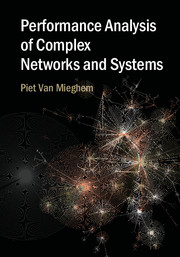Book contents
- Frontmatter
- Dedication
- Contents
- Preface
- Symbols
- 1 Introduction
- Part I Probability theory
- Part II Stochastic processes
- Part III Network science
- 15 General characteristics of graphs
- 16 The shortest pat problem
- 17 Epidemics in networks
- 18 The efficiency of multicast
- 19 The hopcount and weight to an anycast group
- Appendix A A summary of matrix theory
- Appendix B Solutions of problems
- References
- Index
17 - Epidemics in networks
from Part III - Network science
Published online by Cambridge University Press: 05 June 2014
- Frontmatter
- Dedication
- Contents
- Preface
- Symbols
- 1 Introduction
- Part I Probability theory
- Part II Stochastic processes
- Part III Network science
- 15 General characteristics of graphs
- 16 The shortest pat problem
- 17 Epidemics in networks
- 18 The efficiency of multicast
- 19 The hopcount and weight to an anycast group
- Appendix A A summary of matrix theory
- Appendix B Solutions of problems
- References
- Index
Summary
The spread of information in communications and on-line social networks is similarly described as the virus spread in a biological population. In epidemiology (see e.g. Bailey (1975); Anderson and May (1991); Daley and Gani (1999); Diekmann et al. (2012)), two simple “compartment” models form the basis on which many variants exist: the Susceptible-Infected-Susceptible (SIS) and the Susceptible-Infected-Removed (SIR) models. Both models start with infected items that can infect their direct, healthy neighbors that are susceptible to the disease. In the SIS model, each infected item can cure and become healthy, but susceptible again after recovering from the disease, while in the SIR model, the infected item that recovers (or dies) is removed from the population and from the infection process. Just as in queuing theory where the Kendall notation (Section 13.1.4) specifies the queueing system, epidemic models mainly differ by the number and type of compartments. Typical compartment names are healthy, but susceptible S, infected I, recovered or removed R, exposed to the virus E, alert A, and so on. Before concentrating on epidemic spread on networks, we briefly sketch important modelling aspects in classical epidemiology in Section 17.1.
This chapter mainly focuses on the SIS model, in continuous-time, applied to networks: the epidemic spreads over the links that interconnect the nodes (computers or living beings) of a network.
Information
- Type
- Chapter
- Information
- Performance Analysis of Complex Networks and Systems , pp. 443 - 488Publisher: Cambridge University PressPrint publication year: 2014
Accessibility standard: Unknown
Why this information is here
This section outlines the accessibility features of this content - including support for screen readers, full keyboard navigation and high-contrast display options. This may not be relevant for you.Accessibility Information
- 1
- Cited by
